
Bullet and Splinter Wound Care Page Menu: 1 2 3 4 5 6 7 8 9 10 Next>>
Bullet and Splinter Wound Care in the Golden Age of Piracy, Page 4
Foreign Object Extraction Tools - Forceps
Forceps were simple and ubiquitous, having a large role in removing objects from wounds. As German surgeon Matthias Gottfried Purmann notes when discussing gunshot wounds, "Forceps which have a round Hollowness forward, and some few Points or Hooks in that hollow part, are the most convenient Instruments that can be used for extracting Bullets out of Wounds."1 For a bullet that is not lodged too deeply in the body, sea surgeon John Moyle suggests the use of "large Forceps" for removing it.2
 Bullet Extraction Forceps, reproduction by Milk
Creek Mercantile, From Purmann's quote: a - "round Hollowness forward", b - "Points or Hooks" Bullet Extraction Forceps, reproduction by Milk
Creek Mercantile, From Purmann's quote: a - "round Hollowness forward", b - "Points or Hooks" |
French surgeon Ambroise Paré has the most to say about using forceps in bullet and splinter wounds. He explains that "the magnitude and figure of Instruments fit for drawing forth of Bullets and other strange bodies, are various according to the diversity of the incident occasions."3 He indicates that the various instruments use different mechanisms and are of a variety of sizes, "of all which sorts the Chirurgeon must have divers in readiness, that he may fit them to the bodies and Wound, and not the Wounds and bodies to his Instruments."4
Paré figures a variety of forceps in his text, all of which are named after various birds in reference to the appearance of their jaws. (These can be seen below left.)
Fellow French surgeon Johannes Scultetus also shows a variety of different types of forceps in his book which have quite a bit in common with Paré's selection. (These are seen below right.) He says that his diagrams are made 2/3 the scale of an 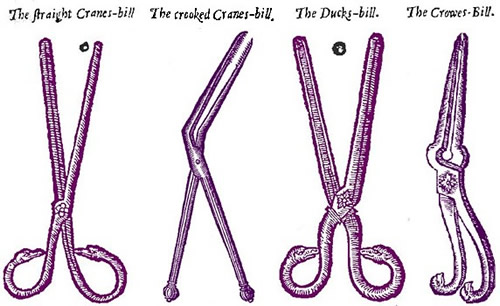
Ambroise Paré's Forceps, From The Workes of that Famous Chirurgion Ambrose Parey (1649) actual instrument, suggesting that the reason the instrument drawings were included were so that readers could take them to blacksmiths or instrument makers and have tools made like them.
Being such simple devices, neither author spends a great deal of time describing the different forceps, although they do provide some interesting information. The straight crane's bill is the type of forceps most often found in antique instrument collections. Of this instrument, Paré says they are good "for drawing forth hail-shot [shot containing small pellets], pieces of bones, and such things as lye deep within."5 Note the difference in bullet size between the more slender crane's bill and the more robust duck's bill forceps in Paré's drawing. Of the straight crow's bill forceps in his book (A), Scultetus only says they "may serve instead of a puller."6
The duck's bill forceps are only found in Paré's book. He says their "bill hath a large round and toothed cavity in the end, for so it more easily taketh hold of the Bullet when it lies amongst the Flesh."7
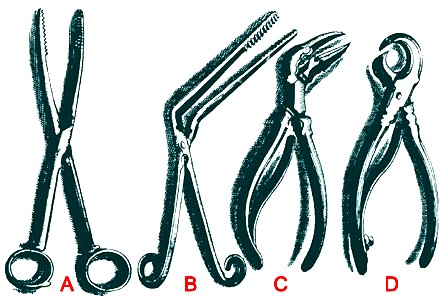
Johannes Scultetus Forceps, From The Chyrurgeons Storehouse, p. 27 (1674)
Forceps Names: A - Crane's Bill, B -
Bent Crane's Bill, C - Crow's Bill, D - Parrot's Bill In his diagram, Paré identifies the crooked crane's bill forceps as having "teeth like a saw", which would make them more able to grab soft lead bullets. Scultetus also pointedly notes the teeth on this tool (B), advising that it is "fit to take forth small bullets, and strange bodies, and to draw them forth of wounds."8 The crooked crane's bill forceps would open more uniformly (with the open jaws making less of an angle to the pivot) making it one of the better forceps for drawing deep-set bullets.
Paré has little of interest to say about the crow's bill forceps in his book. While Scultetus' crow's bill (C) are rather different than Paré's, featuring a spring to hold the jaws open, the jaw design is in some ways similar. Regarding function, Scultetus says they are used for the same thing as his parrot's bill forceps (D). These also have a spring in the handle to keep them open. (Paré has a tool with a similar jaw design, but it incorporates a more complicated screw in the handle and so is included in the Other Mechanical Devices section.) Scultetus says the parrot's bill forceps are used "in fractures of the skul, when a splint of the bone must be taken away, either presseth or pricketh down the membranes of the brain."9 Since Paré includes both the crow's bill and parrot's bill in the section on bullet removal, he clearly has other ideas about their usefulness.
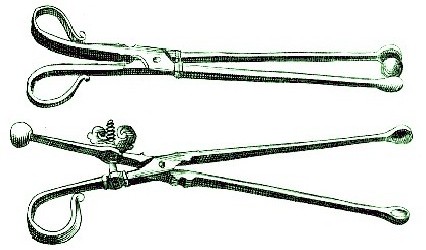
Bullet Forceps, From The Chyrurgeons Storehouse, Johannes Scultetus (1674) Of all the authors describing tools for bullet removal during this period, Scultetus appears to have the widest variety. He includes a couple of forceps with improvements over the simple hand-operated forceps discussed previously. When English surgeon Richard Wiseman was discussing the types of tools available to extract shot, he advised his reader "the Figure of Use of which you may see in Scultetus."10
The forceps seen in the image at left on the top look remarkably like Paré's straight crane's bill forceps. Of them, Scultetus explains that they are "a pair of pincer with a Goose-bill"11. The forceps below them look similar with the addition of a screw to keep them closed. Not surprisingly, Scultetus explains that it is also a goose bill forceps "which hath a screw about the handle, that it may lay fast hold of the bullet."12 Given the fact that the bullet was likely slippery with blood or other bodily fluids as well as being deformed more than the round ball seen in the upper image, this would seem to be a good addition to the tool.
2 Matthias Gottfried Purmann, Churgia Curiosa, 1706, p. 184; 2 John Moyle, The Sea Chirurgeon, 1693, p. 74; 3,4,5 Ambroise Paré, The Workes of that Famous Chirurgion Ambrose Parey, 1649, p.316; 6 Johannes Scultetus, The Chyrurgeons Storehouse, 1674, p. 28; 7 Paré, p. 316; 8 Scultetus, p. 23; 9 Scultetus, p. 26; 10 Richard Wiseman, Several Chirurgicall Treatises, 1686, p. 341; 11,12 Scultetus, p. 39
Foreign Object Extraction Tools - The Terebellum
The oldest known device designed specifically for removing bullets is the terebellum, which is also called by a variety of other names including bullet extractor, piercer, bullet drawer, bullet screw or gimblet. 'Terebellum' is Latin for borer, which reflects the function of this tool.
 Photo: Mission - Terebellum or Bullet Extraction Screw, reproduction by G. Gedney Godwin |
The use of this device is fairly simple. There is a sharp screw a at the end of the tool which is set on the bullet once it has been located inside the wound. The instrument would then be held steady using the rectangular section b so that the surgeon could screw the sharpened point into the deformed lead bullet in the wound by turning the handle c. Once the screw had been drilled into the lead bullet, the surgeon could pull it out, gaining extra force by sliding his pointer and middle finger through the two rectangular holes.
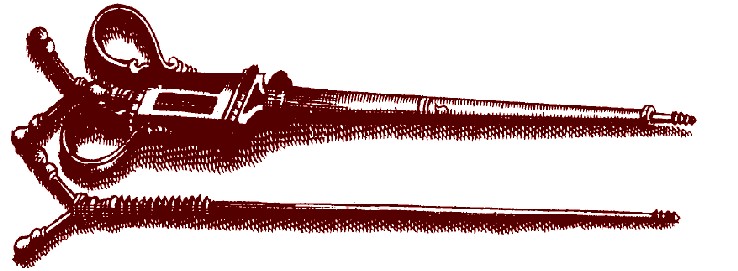 Terebellum With Inner Screw Shown Separately, From The Chyrurgeons Storehouse, By Johannes Scultetus (1674) |
The construction of the terebellum 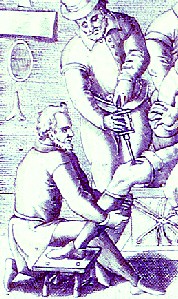
Removing Bullet with
Terebellum,
From Jacques
Guillemeau
(1594) can be seen in an image found in Johannes Scultetus' book. Scultetus explains that it "is a most sharp piercer, in its pipe, with which gunshot are taken forth."1 He shows the inner screw removed from the tool, which is threaded near the top and at the end. Ambroise Paré recommends the use of this device on "strange bodies, especially bullets and hail-shot". He describes its operation in somewhat less detail. "These Gimblets are screwed into their pipes, or canes, and enter with their screwed points into the Bullets if that they be of Lead or Tin, and of no harder metal; and so being fastened in them, bring them out with them."2 Jacques Guillemeau, one of Paré's students, gives a little more insight into the reason this tool was appropriate. "We use this Instrumente, when the bullet is fastened in any bone, & whé[n] the same with violence must be drawen therout: & is in Latine called Terebuellum torculatum cum Canula."3 So it seems to have been primarily used when a bullet was firmly lodged in the body and needed some force to be removed.
Not everyone was a fan of the device. When describing the terebellum, German surgeon Matthias Gottfried Purmann says he had one when he started his surgical career "which I used to carry with me at my first going into the [military] Camp, but to no purpose, for it is impossible with that Instrument to take hold of any Bullet that lies in the Body."4 Purmann instead recommended his readers use bullet forceps because, as mentioned previously, they "are the most convenient Instruments that can be used for extracting Bullets out of Wounds."5 Although no one mentions it, screwing even the sharpest pointed end of a metal tool into a bullet lodged against a bone seems like an incredibly painful prospect. Even so, there are a variety of images of surgeons using terebellums to extract bullets.
1 Johannes Scultetus, The Chyrurgeons Storehouse, 1674, p. 39; 2 Ambroise Paré, The Workes of that Famous Chirurgion Ambrose Parey, 1649, p.317; 3 Jacques Guillimeau, The French Chirurgerie, 1683, not paginated; 4,5 Matthias Gottfried Purmann, Churgia Curiosa, 1706, p. 184
Foreign Object Extraction Tools - Other Mechanical Devices
A variety of other mechanical tools were invented for the removal of foreign objects. While they appear in the texts that focus on different types of instruments, they are not usually mentioned by other surgeons, suggesting they may not have been as widely used as the simpler forceps and terebellum. In addition, since most sea surgeons were newly trained, they would probably have not been able to afford such elaborate devices. However, the ingenuity of some of these designs makes them worth including.
 A Catch-Bullet, From The Workes of that Famous Chirurgion Ambrose Parey (1649) |
Ambroise Paré includes a couple different intricate bullet removal tools. One of them he refers to as "catch-bullet"1, seen above. This has two jaws which are designed to encapsulate the bullet. The jaws in the image make it look remarkably like a Venus fly trap. Paré doesn't detail the use of this device, only describing its workings in the simplest terms. However, from the image, it can be seen that the opening of the jaws would have required a fairly large space around the bullet, making it appropriate only for large, open wounds. In addition, even 
Lizard's Nose Catch-Bullet, From The Workes of that Famous Chirurgion Ambrose Parey (1649) though bullets were round during this time, they varied in size, limiting the usefulness of such a tool.
Paré figures another type of catch-bullet which he explains is "called a Lizards-nose, made for drawing out of bullets which are somewhat flatted, by striking upon the bone."2 Although the jaws appear to require less space to open in this image, they would actually require more because they would have to be longer than the round catch-bullet discussed above.
The last mechanical bullet extraction device that Paré shows he calls a parrot's beak, the nose design of which is similar to Scultetus' parrot's bill forceps. 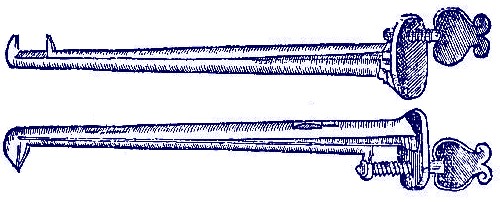
Parrot's Beak Extractor, From The Workes of that Famous Chirurgion Ambrose Parey (1649) This is not actually designed to remove bullets, as the narrow beak suggests. He explains, "The Parrots-beak is made for drawing forth pieces of mail [referring to armor] thrust into the flesh, or bones"3. By the golden age of piracy, armor was no longer in popular use, particularly on ships where it would be unwieldy and mostly pointless. Armor was designed to deflect arrows which were only used by natives by this time. However, it could have been used to grab other foreign objects including splinters, clothing and metal shards. The design would be more conducive to narrow bullet wounds than any of his catch-bullet tools.
Johannes Scultetus includes two interesting designs for mechanical bullet extractors in his book. The first of these 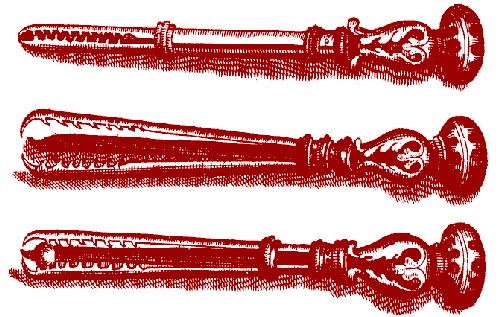
Alphonsinum, Top - Closed, Middle - Open, Bottom - Closed on Bullet,
From The Chyrurgeons Storehouse, By Johannes Scultetus (1674) he calls the Alphonsinum after its inventor, 16th century Italian physician Alphonsus Ferrus. Scultetus says that it is based on crane's bill forceps. "To this we (that it may be more commodiously and firmly held in the hand, and so bullets and other strange things in wounds may be found out more certainly) have added rings for pincers"4. He goes on to explain that the lower ring "thrust to the former part [the jaws] of it, shuts the instrument", while the upper ring, "being drawn back to the handle, the instrument is opened."4 This device is more clever than the catch-bullets in that it can be closed when going in so that the metal 'fingers' don't harm the sides of the wound on the way down. In addition, it doesn't need to be opened as wide as the catch-bullets once inside the wound. However, it could only go in as deep as the lower ring when it was completely shut if the operator still wanted to be able to open the jaws.
Scultetus shows a second device which combines the functions of Paré's catch-bullet with the terebellum. He says it is "the most fit to take 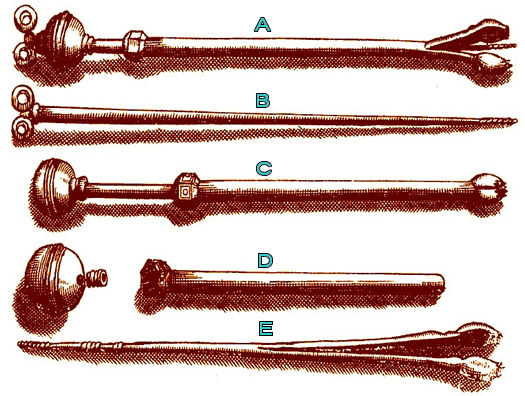
Catch-Bullet With Piercer,
From The Chyrurgeons Storehouse, By Johannes Scultetus (1674) forth bullets out of a wound. It is made of the best steel"5.
The tool as well as the individual components taken apart are shown in the diagram at right. At the top is the assembled tool (A) showing the catch-bullet jaws with a piercing screw protruding from the middle. The piercer is shown separately below that - (B). Note that it not driven by a screw into the handle like the terebellum, but slides freely in and out. (This has the added advantage of making it easily removed if the surgeon was unable to screw into the bullet.) The catch-bullet without piercer appears in the middle of the image (C) with the jaws closed. It works using a hollow rod (seen below the assembled catch-bullet with the top unscrewed from it (D)). As this hollow rod is pushed down on the normally open bullet, the toothed 'spoons' at the end are forced closed (E). It's quite an intricate device, although it suffers from the problems of both the terebellum and the catch-bullet.
1 Ambroise Paré, The Workes of that Famous Chirurgion Ambrose Parey, 1649, p.316; 2,3 Paré, p. 317; 4 Johannes Scultetus, The Chyrurgeons Storehouse, 1674, p. 39; 5 Scultetus, p. 37

